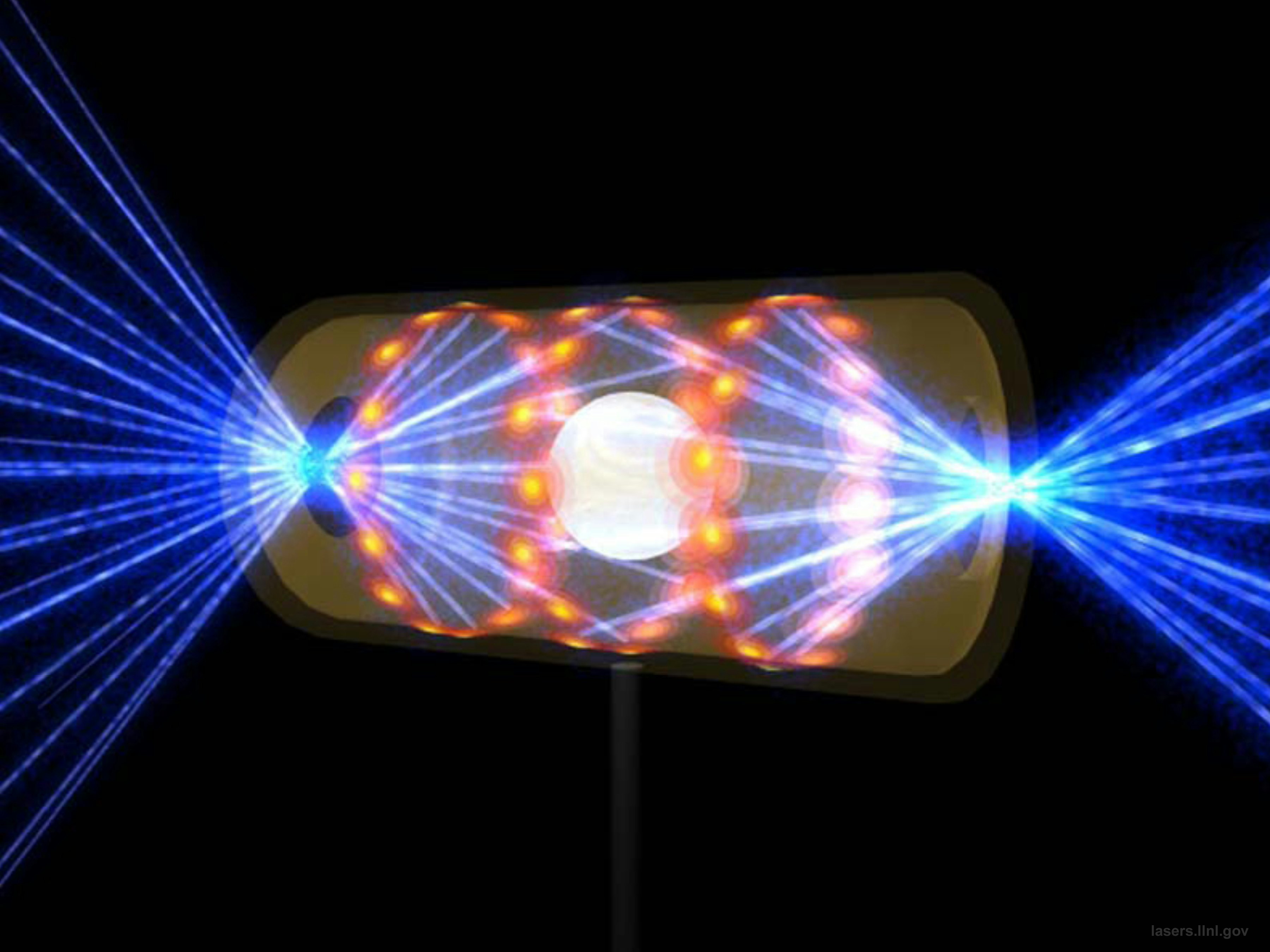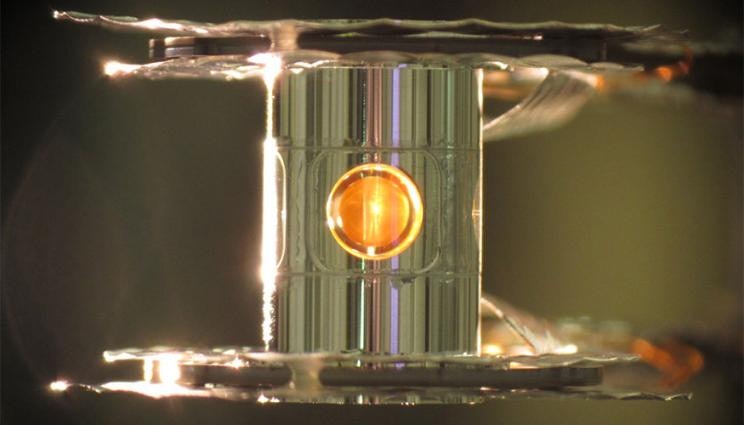
Whether it’s powering a flying DeLorean or helping us break free from our dependence on fossil fuels, the concept of nuclear fusion has long seemed futuristic and unattainable. Now, this future is finally coming into sharp relief in light of a new report from the National Ignition Facility (NIF) at Lawrence Livermore National Laboratory.
According to the report published Wednesday in the journal Nature, nuclear scientists from NIF have proven through four experiments that it is possible to achieve burning plasma — a crucial milestone along the journey to full nuclear fusion.
Omar Hurricane is a co-author on this paper and chief scientist for the Inertial Confinement Fusion Program at Livermore National Lab. He says that these experiments are a technical triumph that brings nuclear physics one step closer to recreating the kind of sustained nuclear fusion that burns inside the heart of a star.
“These papers report on the first experiments to surpass this burning plasma threshold,” Hurricane tells Inverse. “The physical conditions required to generate a burning plasma are extreme, and it requires very precise control to make it happen … enabling the potential for rapidly increasing fusion performance.”
Here’s the background — When you think of nuclear energy, it probably brings to mind images of conical smoke stakes reminiscent of Homer Simpson’s boring desk job. This kind of nuclear energy is called “fission.” It happens when atomic nuclei — the center of atoms — are broken apart to release energy bursts that create electricity by powering steam. While nuclear fission is a greener alternative to oil and coal, it has often faced criticism over mismanagement of aging facilities (think the Chernobyl meltdown) and the toxic waste it leaves behind.
On the other hand, nuclear fusion has a much cleaner public persona. By smashing light nuclei together to create one heavy one (e.g., two hydrogen atoms creating one helium atom), nuclear fusion could create clean, self-sustaining, and waste-free energy. In a world of clean energy sources that struggle to generate power on cloudy or still days, an autonomous energy source could be huge.

The big catch, though, is that nuclear fusion is not only incredibly difficult to do but even measuring crucial milestones — like burning plasma — presents a challenge, says Hurricane.
“For fusion plasma to be able to produce more energy than was used to create it… it must first be able to heat itself (‘self-heating’) by retaining some of the energy generated during fusion,” explains Hurricane. “The threshold at which the fusion plasma self-heating just exceeds the external sources of heating applied to make it is what we call a ‘burning plasma’.”
“[However,] a burning plasma has no obvious data signature, so we use data inferences to understand if the energy balance in our plasma has shifted into a burning state or not,” he continues.
This uncertainty can mean that making the call of whether or not their experiments have really achieved burning plasma is difficult, but Hurricane says that the team is confident in their new paper that they have finally done it.
Why it matters — Achieving burning plasma doesn’t mean that fusion energy is coming to our homes anytime soon, but it does represent a big step toward this goal.
Alex Zylstra is the first author on the new paper and an experimental physicist at Livermore National Lab. He says that this work will bring fusion research even closer to its goal of clean, self-sustaining energy.
“The dream of fusion is that it can provide a carbon-free, safe, and reliable source of energy,” Zylstra tells Inverse. “Creating a burning plasma is a clear milestone on the way towards demonstrating energy production from fusion that would be relevant for power production.”

What they did — As for how you go about creating nuclear fusion in a lab on Earth, here’s what the team did:
- A spherical capsule of deuterium-tritium fuel (which can be created in part from seawater) is placed in a hollow container called a hohlraum
- In a process “indirect drive inertial confinement” fusion, 192 lasers are pointed at the hohlraum to generate x-rays
- These x-rays heat the fuel capsule and hohlraum such that the fuel capsule compresses thousands of times its original volume in only a fraction of a second
In the recent paper, the team describes four experiments that followed this technique, and Hurricane says that by measuring the energy balance in the plasma, they were able to determine an energy yield of up to 170 kilojoules of energy. While this doesn’t yet surpass the amount of energy put into generating the reaction, it was many times greater than previous experiments.
What’s next — As science is never written in stone, the authors note that these recent results described in Nature have already been surpassed this August by another experiment of the same type at NIF. While the team published a press release on these results in 2021, Hurricane says the team is writing the paper on this result as we speak.
Ultimately, the results in this and the forthcoming paper are evidence that self-sustaining nuclear fusion is no longer a thing of science fiction. That said, your fusion-powered car may still have to wait.
“Our current focus is on the science - NIF is an experimental facility and not geared towards power production,” says Zylstra.
Abstract — Obtaining a burning plasma is a critical step towards self-sustaining fusion energy. A burning plasma is one in which the fusion reactions themselves are the primary source of heating in the plasma, which is necessary to sustain and propagate the burn, enabling high energy gain. After decades of fusion research, here we achieve a burning-plasma state in the laboratory. These experiments were conducted at the US National Ignition Facility, a laser facility delivering up to 1.9 megajoules of energy in pulses with peak powers up to 500 terawatts. We use the lasers to generate X-rays in a radiation cavity to indirectly drive a fuel-containing capsule via the X-ray ablation pressure, which results in the implosion process compressing and heating the fuel via mechanical work. The burning-plasma state was created using a strategy to increase the spatial scale of the capsule through two different implosion concepts. These experiments show fusion self-heating in excess of the mechanical work injected into the implosions, satisfying several burning-plasma metrics. Additionally, we describe a subset of experiments that appear to have crossed the static self-heating boundary, where fusion heating surpasses the energy losses from radiation and conduction. These results provide an opportunity to study α-particle-dominated plasmas and burning-plasma physics in the laboratory.







